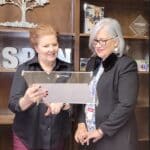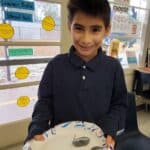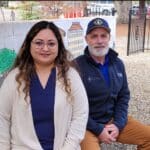Charter school oversight is evolving. What once typically entailed emergency interventions and petition renewals every five years is becoming more intentionally focused on the goal of helping all charter students succeed by becoming a conduit for information and support between charter schools and authorizers. CCAP has begun profiling California authorizers that are reshaping the authorizer-charter school connection. In this issue, we explore how Fresno Unified School District is working to grow trust and cooperation with its charters.
Not too long ago, many charter school leaders were reluctant to ask their authorizing district or county office of education for assistance out of concern over perceived authorizer indifference, interference, or lack of information about regulations and systems.

Shelly Lether, Executive Director of Aspen Public Schools, and Felicia Olais, Manager of the Charter Office at Fresno Unified School District
The latter issue was a key concern for Shelly Lether, executive director of Aspen Public Schools, which operates three charter schools authorized by Fresno Unified School District (FUSD). She knew that the district supported its charter schools but ran into obstacles when district staff were either not current on state guidelines — which is a common frustration for many small, understaffed authorizers — or had a different interpretation of the guidelines. More worrisome to Lether was what she felt was an unspoken message that seeking help might send. They might think, “You’re messing up. You must not be doing something right.”
Authorizers, too, were unsure about how to, or even whether to, strengthen lines of communication. For good or for bad, the standard operating procedure was generally to keep their distance until renewal time came around or a serious problem arose. Some schools preferred things this way.
Fresno Unified is now one of many California authorizers working to change that dynamic as authorizers and charter schools realize the benefits of cooperation, including smoother operations, stronger accountability, and higher student success rates.
Building District & Charter Collaboration
Six years ago, Jeanne Pentorali became executive director of Dailey Elementary Charter School in Fresno Unified, a kindergarten to fifth grade school with 350 students. She always felt welcomed by the district, but she sometimes found the procedures confusing, such as the first time she led Dailey Elementary through the charter renewal process.

Fourth grader Matthew Sanchez at Dailey Elementary School
“It was kind of like, I think this is how we do it, but I’m not positive,” Pentorali recalled, though she acknowledged that there are always new challenges to work through between charter schools and authorizers. “The charter world is unlike anything else; there’s a lot of learning, and sometimes I feel like we’re just individual ships trying to figure it out.”
That feeling of isolation began to lift two years ago, when Felicia Olais became manager of FUSD’s charter office. “She’s done a great job trying to put the pieces together and build those systems so we can move forward in a very solid and collaborative way with all being on the same page,” said Pentorali.
Olais is a goal-oriented, optimistic, and gentle force of nature and nurture. Her approach is to build trust and cooperation between the district and its charter schools by being a reliable source of information and practical support. Even though the charter management office is a two-person department, it coordinates with many other district offices to support and oversee charter schools.

An Endeavor Charter School onsite high school classroom
When Endeavor Charter School, a TK-12 independent study hybrid, was shopping around for more space, Olais asked the district facilities staff to help inspect an additional school site Endeavor was considering leasing. Nancy Garcia, a co-principal of Endeavor, said that teamwork and responsiveness illustrated Olais’ belief that charter schools and their students are as valued as all other schools and students in the district. “That was new to me,” said Garcia.
University High School Superintendent/principal Jeffie Esparza Hickman hit an administrative snag after a change in the state’s teacher credential requirements left some of her veteran teachers in limbo shortly before the start of a new school term. Human resources staff at the district and county office of education had interpreted the new guidelines differently, so Esparza Hickman asked Olais for help.
“It wasn’t until Felicia stepped in, then she actually would call someone for me and say, ‘Would you talk to this person?’” Olais scheduled a virtual meeting with everyone involved to agree on a shared process.

University High School Class of 2022
Sitting a few feet away, Olais gamely interjected, “That’s why I was hired: to help be that bridge for communication when things break down.”
Her greater goal is to prevent those breakdowns from happening in the first place. Her ultimate goal is that these changes improve student success.
You Can’t do This Alone
Olais credits her predecessors with laying the groundwork for strengthening authorizer-charter cooperation. She is of the school of thought that no one can drive change alone.
“You have to acknowledge the people who have traveled the road before you,” explained Olais, noting that it has been three decades since California passed the Charter Schools Act of 1992. “I’m at the surface right now. But you’ve got people out there who have been involved for 30 years with the charter world and charter education and they have so many lessons that we can learn from.”
The first lesson was already awaiting her when Olais stepped into the manager position: COVID. All schools were operating in survival mode, and building better relationships with the district was not a priority for charters. This reality, coupled with the state’s two-year pause on charter renewals, gave Olais some breathing room to get organized, she said — exhaling deeply as if on cue.
“What I quickly understood is that this [charter] world is a shifting ground,” noted Olais. She spent the unanticipated time developing ideas for building relationships with the charters and searching for information and resources to share with them.
Olais is also a big believer that learning never ends. She participates in CCAP workshops, attends the monthly virtual Charter Chats organized by the Charter Authorizer Support Initiative (CASI) managed by the state department of education, and encourages charter leaders to continue with professional development. When charter schools have settled into a new normal following COVID’s total disruption of education, she plans to bring back regular meetings of charter leaders to get to know each other, exchange ideas and collaborate.
Accountability
Fresno Unified School District has over 70,000 students, making it the third largest school district in the state, behind Los Angeles Unified and San Diego Unified. Of the 3,100 students enrolled in the district’s ten charter schools, 65-70 percent reside within the authorizing district’s boundaries. While Fresno Unified is a smaller authorizer than these other two districts (Los Angeles Unified has 275 charter schools), being a charter authorizer brings a critical mass of responsibilities regardless of size, especially reviewing renewal petitions.
During COVID, California extended charter renewals until 2024. Some renewals, which assess accountability in student achievement, finances, governance, and equity, are already underway, although proposed legislation would further extend them. Completing a renewal petition is a lengthy and complicated process that can be compounded by ambiguous guidelines.*
Part of the process includes an annual visit from the authorizer to check for compliance, which charter leaders say adds to the stress. Olais has added a pre-meeting with the district that describes what the review team will be looking for during the visit and give charter leaders a heads-up on missing or incomplete information.
“I always appreciate feedback because if we’re not doing something that we should be, I want someone to tell me. I don’t want to hear about it later, I want to hear about it now so that we can fix it,” said University High’s Esparza Hickman.

CCAP Executive Director Tom Hutton with Felicia Olais and Fresno County’s Jeff Hunt
She is even more excited about the matrix created by Dr. Jeff Hunt of the Fresno County Office of Education that Olais adopted for the district. It shows in detail exactly what documents and information are required for renewals. The matrix is “like gold,” exclaimed Esparza Hickman. “I know exactly what to put in our petition. This is like pretty much like the playbook of what to include.”
The matrix also makes site visits more productive because the district team can point out specific subsections that need additional work, said Michael Cox, executive director of Western Sierra Charter Schools, the charter management organization for FUSD’s Endeavor school. He also appreciates that the schools are wholly engaged in the process.

Nancy Garcia, a co-principal of Endeavor Charter School, and Michael Cox, executive director of Western Sierra Charter Schools
“Olais is keeping us involved with the very criteria that we will be evaluated on at renewal time,” said Cox. “We’re able to respond, improve, tighten up,” and be “prepped and ready when it comes time for renewal.”
The new process has boosted collaboration between the district and charters by more than a few notches. In the past, charter schools often viewed the site visits with apprehension, waiting for a “gotcha” moment, said Lether of Aspen Public Schools. FUSD’s system takes the pressure off, she added, “you know it’s not their goal to shut them down, but rather to see their charters be successful.”
*CCAP has toolkits online to help guide authorizers through the initial charter petition and annual report (for renewals) processes.
